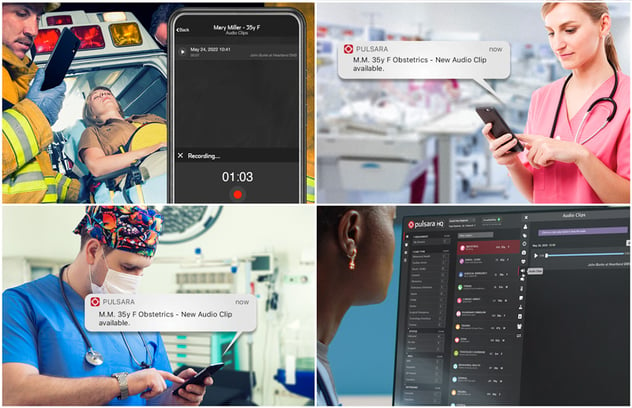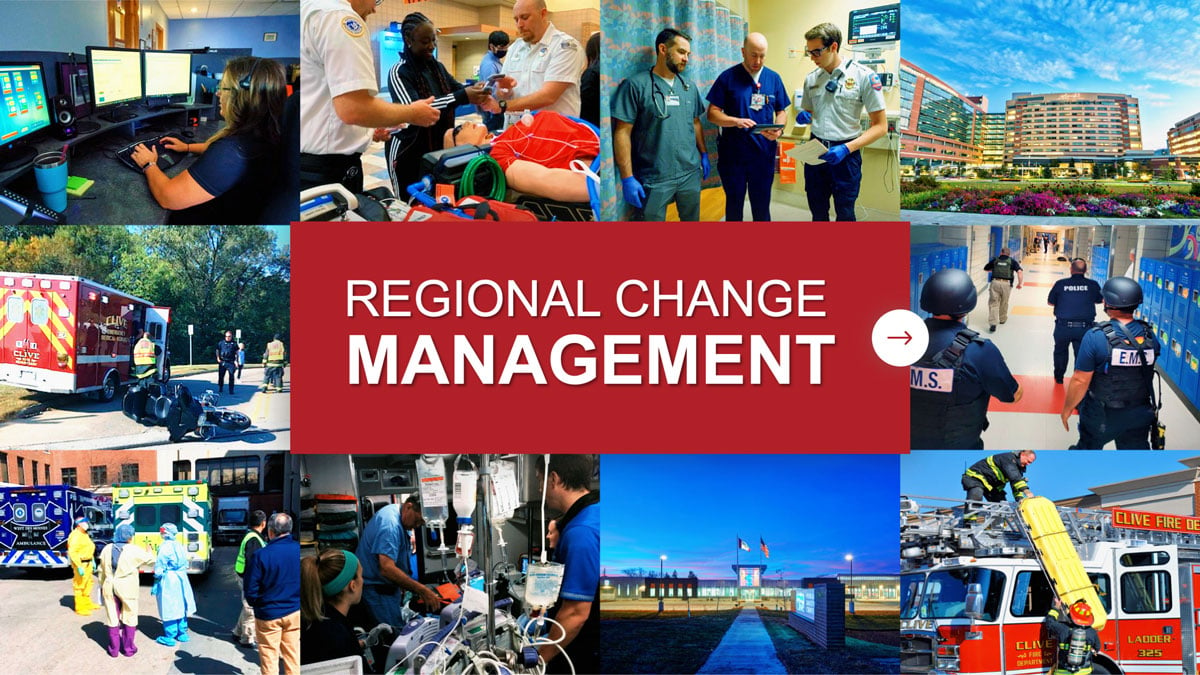Change is hard for everyone. Very few people truly enjoy the process of changing the way things have always been done. As a result, establishing a new way of doing things can be an unpopular decision.
So what do you do when change is necessary? How do you make sure it's successful? Change is hard enough to enact across a single organization. How do you create successful change when it's necessary across your region?
These are questions that healthcare leaders from Colorado Springs, Colorado and Des Moines, Iowa have recently grappled with. The Colorado Springs and Des Moines regions have a striking number of similarities. Both serve a population of around 700,000, have three health systems, and account for around forty EMS agencies. Both have also revolutionized their regional communication with Pulsara, which has allowed them to enable faster, better communication for their healthcare providers.
Leaders from both regions recently hosted a webinar to share their challenges and successes in bringing a new communication system into their region, and what they learned in the process. Watch the full webinar below, and check out these six takeaways for anyone considering how to approach change management across a region.
1. Establish the why: why is it important to change?
When it becomes evident that change is necessary, it's important to bring all stakeholders on board with the issue and communicate why the change is needed. Once everyone is aware of the problem, it becomes easier to get buy-in for your chosen solution.
When leadership in Colorado Springs identified that they had a need for a new way to communicate among providers, they first acknowledged and confirmed the problem they were facing. According to E. Stein Bronsky, MD, Co-Chief Medical Director, Colorado Springs Fire Department, Co-Chief Medical Director, El Paso County, CO American Medical Response (AMR), and Medical Director, El Paso-Teller County 911 Authority:
"It was important for us in the Colorado Springs region to understand the amount of errors in communication and the amount of delays that came with the communication status quo. That's something that I think the health care system just viewed almost as a commodity. There were just simply, quote-unquote, 'limitations,' that nobody could get over. But we saw through Pulsara that we no longer needed to accept the antiquated and fragmented communication system, and therefore we would be able to solve a tremendous amount of the delays and misinformation and miscommunications that existed in the past."
2. Make sure the right people are involved.
How do you bring a diverse group of stakeholders to the table, align incentives, and get people on board with deciding to take action? Get the right people involved.
Healthcare leadership in Des Moines did this right away, and it helped smooth the process of transitioning to Pulsara. Brian Helland, Operations Chief of the Clive, Iowa Fire Department, described how the relationships they had already built up between different organizations helped facilitate the process.
“I think that we were very fortunate to already have a group established between the different health systems and with EMS, through our Central Iowa EMS Directors Association. One of the things that helped us out a lot is we had a lot of those people already at the table during regular meetings. And over the years we had developed some good relationships, and there was some trust between both of the health systems that were involved, and transparency and data sharing. We knew that we were all there for a common good."
Additionally, according to David Edgar, MHA, CCP, NAEMT Board of Directors Region III, CAAS Board of Directors, and Assistant Chief of EMS for the City of West Des Moines, Iowa, it's important to have those with decision-making power on board with your vision.
"[Engaging stakeholders] was a challenge. We kind of initiated this process from the EMS standpoint, and had to bring the hospitals in. I have a little bit of experience with hospital systems other than EMS and I think it became pretty evident as we got down to trying to solve all the problems we identified. You know, Pulsara was able to do that, but the people that were at the table at that point were the people that have to do their budgets and stay within their budgets. And we quickly realized that there's a next level of people that make decisions outside of budgets and different things. And we brought them into our group and explained what was going on. And we also brought some key physicians in that were frustrated with some of the processes. So I think that was a key: getting the right people at the table that were the real decision makers. Because the original people we had in there, you know, they were going to struggle with their budgeting process of getting anything done with that. So that helped on our end."

3. Building community With User Groups is vital to successful change.
When implementing a region-wide change, it’s important to have a support network. Leaders in both regions described how they built regional user groups that met quarterly and semi-annually. Dr. Stein Bronsky attested to the fact that the user group has been essential to the success of their new communication platform:
"We do have a committee that we call the Regional Health Care Communication Committee, and that really birthed out of the Pulsara project because we began to notice very early on that if we didn't have on a regular basis, all of the stakeholders from the hospital systems and the service lines and the EMS agencies meeting together, that we were going to try to establish a system that would just be left out there in the open. And it was prone for degradation and falling apart from many different aspects. And so we recognized that the critical importance—and I would say this is one of the absolute staples of our program—is to have that communications committee where all of the stakeholders get together on a regular basis. We're able to discuss any issues that come along in a non-attacking environment. We're all there for the good of the patients and the good of the community, and we discuss what our issues are, what's going well, what's not going well. It also provides a systematic venue for people to bring issues to the table that we can put through our QA and CQI process. And so I can't imagine the continued success of our communications platform and this regional systems of care without that committee."
4. Data can demonstrate improvement and win people over.
Tangible evidence showing both the problem and the success of the solution can be greatly beneficial in winning over key stakeholders. Matthew Angelidis, MD, UCHealth ER Physician, Medical Director UCHealth EMS, Co-Medical Director CSFD/AMR, and Co-Medical Director Plains to Peaks RETAC described how this looked during the change management process in Colorado Springs:
"We use evidence-based medicine to drive decisions and what we do for patients, and the implementation of Pulsara in our system of care is no different. So when we look at STEMI care in our community, we track all kinds of things for our hospital systems to obtain their accreditation, like door-to-EKG times, or EMS scene time, time to aspirin administration, door-to-balloon, or cath time. We were able to take those data metrics that we track regularly within our health care systems, and we were able to demonstrate that when we use a patient care channel in Pulsara, we are delivering expedited and more accurate care to those patients. Our cardiologists are viewing the EKG in real time with our EMS field providers. And they are controlling the switch to turn on the cardiac cath lab. They are communicating directly with those EMS providers, asking for additional data, more history, additional information, and we found within our community that we really, really improve the quality of care those patients receive by connecting the entire team that would be involved in that patient's care right up front, in real time with our EMS providers in the field. We did the same thing with stroke and door-to-balloon times, door-to-tPA times. We're able to track all those metrics and look at how Pulsara impacted the speed with which we deliver care patients need."

5. Identify and empower champions in your organization who can help drive change.
Change within and across organizations can be nearly impossible without backing from the right people. That's why it's important to identify key individuals who are willing to act as champions for the project and can help push it to the finish line. Dr. Bronsky spoke to the necessity of identifying and empowering champions within your organization:
"I think having champions is absolutely paramount. And we learned through our trials and errors that if we did not have good champions—actually, I will rephrase that to say the champions that are decision-makers and that can actually feed a mission to the service line or the hospital or the EMS agencies—that is so, so vital. If we don't have that, then the situation and the implementation just seem to remain in an eddy and not move forward very much. And so we recognized very early on that we needed champions not only in each EMS agency to take responsibility for the agencies, but we also had to have a champion high up in the hospital administrations at the very highest level. And then that filters down to champions through the different service lines. That's the only way that we really felt as though we were actually being able to move forward and get to our goal of what we wanted to happen."
6. Don't get discouraged; successful change doesn't happen overnight.
Coordinating change across multiple organizations is no easy task, and even when things do go smoothly, it doesn't always happen as quickly as desired. Don't get discouraged; this is part of the process.
Chief Helland described how this became evident during their change management process:
"I think one of the big learning points for us in the EMS world was that organizational change is a very slow thing. It's easier for us in the EMS world to make those organizational changes. EMS agencies are typically smaller and more agile than an entire health care system. And so we were able to implement the change in the pre-hospital world a little bit easier, and trying to make sure that we found the correct stakeholders within the hospital system was one of our bigger challenges.”
Stay tuned for part 2, in which Dr. Bronsky, Dr. Angelidis, Chief Edgar, and Chief Helland share more tips for effective regional change management!

For more information on successful change management, check out these 4 Keys For Managing Change Amid Chaos.
 Team Pulsara
Team Pulsara



![[PRESS RELEASE] Published Research Finds Up to 31% Faster STEMI Treatment Times in Rural Hospital Setting with Pulsara](https://www.pulsara.com/hubfs/_1_website-page-blog-assets/pulsara-hosp-teams-assign-cardio-stemi-rn-1200x701.jpg)

